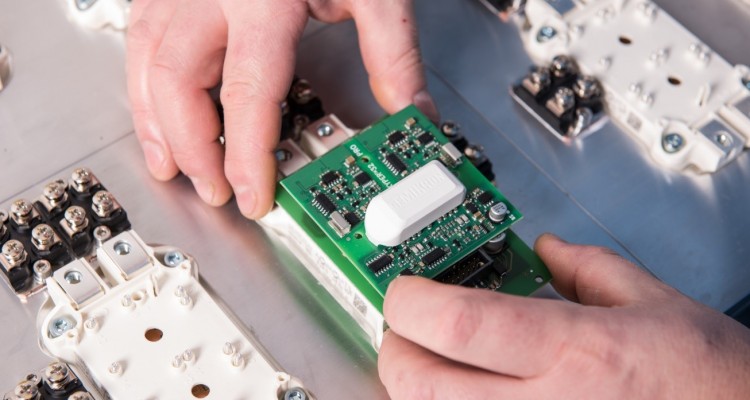What is an Isolated Gate Bipolar Transistor?
Before the development of the IGBT, power electronics engineers had two types of device available for higher frequency switching – the Bipolar Junction Transistor (BJT) and the Metal Oxide Field Effect Transistor (MOSFET). Both devices could switch at higher frequencies than Thyristors (or SCRs) but each had some limitation. MOSFETS offered high switching speeds, but high voltage and high current designs were relatively costly, whereas BJTs were available in high voltage and high current configurations, but offered somewhat lower switching speeds.
Isolated Gate Bipolar Transistors (IGBTs) are three terminal switching devices, which could effectively be considered to consist of an insulated gate N-channel MOSFET combined with a PNP Bipolar Junction Transistor. The IGBT combines the high voltage and current capability of the BJT with the voltage control characteristics of a MOSFET, allowing higher frequency switching.

How do IGBTs work?
The IGBT has three connections, Collector, Emitter, and Gate. The conductance path is through the Collector and Emitter. Similar to a Thyristor, the IGBT allows current to pass when a signal is received at the Gate. A thyristor is “current controlled” and switches “ON” when a pulse is provided to the Gate. The IGBT is voltage controlled, allowing conduction when a positive voltage is present on the Gate, and only switching “OFF” when the voltage is reduced to zero, or ideally, driven negative.
The output current and voltage characteristics are similar to the BJT, but driving the device using the voltage control of the MOSFET simplifies the switching. Another important advantage over standard MOSFET operation is a lower on-state voltage. The resistance offered by the conducting channel in an IGBT is very much smaller, leading to much higher current ratings than for an equivalent power MOSFET.
What are IGBTs used for?
IGBTs are the ideal choice for switching current on and off in high power applications. IGBTs are designed for use in power applications above 1kW, the point at which BJTs and standard MOSFETs reach their limits, switching at frequencies between 1 kHz and 20 kHz. Low voltage applications (<600V) tend to be high volume consumer oriented, for example to control motor drives for washing machines. Key applications include automotive (electric vehicles), rail traction equipment and industrial motor drives, where operating voltages are higher – 1200V or 1700V are typical of the standard ranges available.


In many applications, rather than using multiple discrete devices, IGBTs are combined into modules, to offer complete circuits for specific power control.

IGBT Modules from Semikron
SEMIKRON offers IGBT modules in SEMITRANS, SEMiX, SKiM, MiniSKiiP and SEMITOP packages in different topologies, current and voltage ratings. Starting from 4A to 1400A in voltage classes from 600V to 1700V, the IGBT modules are used in a variety of applications offering key technologies like sintering, spring or press fit contacts for simple and fast assembly. Topologies available include CIB (converter inverter brake), half bridge, H-bridge, 6-pack and 3-level, which cover almost all application fields.
Power Products are the Main UK Franchised Distributor for Semikron products, including IGBT Modules and Drivers. Our in house sales team can provide assistance with design issues, and have direct access to the Semikron technical support team in the UK.
By combining the latest Semikron IGBT technology and expertise with Power Products’ Thermal Management and Power Semiconductor system experience, we can provide a one stop shop for electrical and thermal design for power system design solutions. Contact us now to discuss your next generation of IGBT controlled power system designs. info@powerproducts-uk.ltd.

